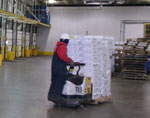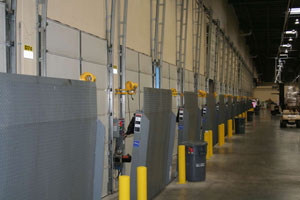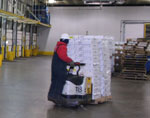
Stopping Food Safety Issues Cold at the Loading Dock

Mark Latsko manages a very busy -- and very secure -- dock at the Anderson-Dubose distribution center in Carnegie, Pa., outside of Pittsburgh. Forklifts enter and emerge from parked semi trailers in a steady stream throughout the company's two shifts, busily handling product for the company's single client that happens to be one of the largest restaurant chains in the world. The quality and safety of the food the client serves is paramount, requiring that security at the facility be tightly controlled and monitored.
"In handling this customer," points out Latsko, "we have to keep an eye on quality throughout the entire cold chain and comply with their rigorous standards, keeping the product at temperature from the point where it is picked up at the processor right to the door of the restaurant. If we don't do that, we don't do business."
It is this business that ultimately needs protection along with that of the food at all points of the supply chain, especially when the process involves maintaining low temperatures.
Losses from food that becomes contaminated during processing and handling can be astronomical, running into the tens of millions of dollars for a single incident. Losses could include inventory that must be recalled, the cost of food disposal, the cost of administering the recall, and the cost of crisis-mode public relations efforts to mop up after the incident.
Immeasurable but even worse is the damage done to the company's image. The investment that built the brand is lost, and it can be years before some customers will buy that brand again or return to an affected restaurant -- if the operation has managed to stay in business.

Busy docks such as those at Koch Foods Inc. must maintain proper temperature levels to protect products.
Even the hint of a problem will cause conscientious companies to deal with it as soon as possible. When frozen food thaws and refreezes, the cell walls break down. This makes the product mushy and tells the consumer that something is wrong with the food on the plate. According to Rick Barthel, general manager for the Koch Foods Inc. facility in Franklin Park, Ill., "To us and to our customers, a bulging box is a damaged box." To eliminate the risk of poor quality perception, many manufacturers toss out the questionable products along with the profits they would have generated.
Crucial in the supply chain is the ability of the loading dock to provide the proper environment to protect food. This can be a challenge. Even though a building is tightly sealed to bottle up the facility's cold storage energy, product must be able to pass through an open door to get in or out of the building.
A doorway that is not properly sealed to prevent energy loss, whether the door is open or supposedly closed, can lead to rising temperatures on the dock. Depending upon traffic flow, pallets of frozen product can be staged on the dock for hours, increasing the risk if temperatures are not kept low enough.
Loading dock equipment, originally meant to protect the safety of dockworkers, should be enlisted to protect food products as well. Here are five questions that will help a DC strengthen this line of defense.
Is the door really shut? Just because the door looks closed doesn't always mean it is sealed. Forklifts are notoriously brutal on everything around the dock doorway, and especially on the dock doors.
A direct impact can render a door useless. Many facilities will attempt to seal up the doorway themselves or use damaged panels to get by. This provides a major avenue for air infiltration. Even slight hits can cause the door to go out of alignment, enabling cold air loss that is usually not detectable but significant nevertheless.
Some docks try to protect doors with concrete bollards or even vertical storing dock levelers. But when forklifts are accessing truck trailers, they often make contact with the guide track, tearing the weather seal, and in some cases the door can sag into the way of the forklift mast and get damaged.
Impactable dock doors provide the protection doorways need when closed but also yield to impacts to prevent damage.
Impactable dock doors are designed with spring-loaded plungers on each door panel that retract when hit, releasing it from the guide tracks rather than resisting the force and allowing damage. These doors also have an impactable track. Unlike conventional steel tracks, it can take a direct forklift impact without suffering any damage. It does not resist the force of the collision and can be quickly reset to minimize dock exposure.
The gasket on the side of the doorway is one of the most important parts of a door, and the most vulnerable. This flimsy part, typically attached to the doorframe, is easily torn off by passing forklifts. Fully impactable doors are designed with the door seal attached to the door panels, not the track, so the seal travels up with the door and out of harm's way during loading.
The other drawback of standard dock doors is that the metal panels and track can conduct heat into the building, causing moisture to form around the dock and become a breading area for bacteria. Impactable doors equipped with ultra-high molecular weight (UHMW) plastic tracks do not conduct heat and prevent moisture build up on the dock area.
Is the dock floor an avenue for airflow? Dock levelers are necessary to allow forklifts to safely access truck trailers and to create the level interface between the warehouse and the trailer. Dock levelers are typically mounted in a concrete pit; however, that configuration creates small gaps between the edge of the dock leveler and the pit wall that exposes the facility to interior and exterior airflow exchange.
With a pit-style leveler, any breeze outside can be detected by simply standing over the gap between the floor and the leveler platform. Tightly closing the dock door all the way to the floor and installing standard neoprene or brush weatherseal does not completely cut off this airflow.
Both new and existing pit-style dock levelers can be outfitted with an advanced weatherseal system comprised of a durable combination of closed cell foam and heavy-duty vinyl that effectively fills the gaps around the sides and rear of the dock leveler and provides a superior seal around the dock leveler perimeter.
Vertical storing dock levelers, primarily used in cold storage applications, don't have these same issues since they store upright and allow the door to seal tight against the concrete floor.
Is there a fully sealed tunnel between the trailer and dock? Even when a forklift is working as fast as it can to load or unload a truck trailer, there is a period of time where the dock door is fully open and the dock is potentially exposed to the outside. Dock seals are critically important to containing cold air in the dock areas. As with damaged dock doors, a poorly specified seal or shelter also allows air and infiltration.
Dock seals have fabric-covered foam pads that compress when the trailer backs into them, providing a tight seal around the sides of the trailer and sealing off the gaps between the trailer's door hinges. Dock shelters consist of fabric attached to side and head frames to create a canopy around the full perimeter of the trailer; they allow full, unimpeded access to the interior of the trailer.
Galvanized steel backing offers many advantages over wood backing that is used on some models. Wood backing has a solid mass (1-1/2" thick) that does not yield when the seal is compressed. This often results in damage to the building. On steel backing, the solid mass is replaced with compressible foam on a steel frame. Steel backing also offers superior durability as it does not rot, split, crack, or warp. It uses plated screws with load-spreading washers in the steel to provide a stronger, more durable hold on the fabric.
Is the trailer snug against the dock? Though largely regarded as a safety device, the vehicle restraint also plays a role in helping seal off the dock doorway. Many food-handling docks use rubber wheel chocks in an attempt to hold trucks in place during loading/unloading. However, rubber chocks are no match for the forces exerted by forklifts driving in and out of trailers.
This force can gradually cause a trailer to "walk" away from the dock, forming a doorway gap. A powered truck restraint ensures that the trailer is held snuggly to the dock, with the back end of the trailer fully enveloped by the dock seal.
Are the dock functions coordinated? Most food handling DCs are marvels of technological advances when it comes to conveyors, WMS, forklifts, and picking systems. The loading dock is usually regarded as the primitive "backroom" of the operation, but automation has finally found its way onto the docks.
All of this equipment plays an energy-blocking role, but if the equipment is not deployed correctly, the dock can be left exposed to the outside.
Master control panels are available to tie all of these functions together. Programming ensures that the dock door is not opened until the truck trailer is parked at the dock and secured by the restraint. The restraint will not release the trailer until the door is fully closed. These control panels can be operated properly no matter the skill level of the dockworkers.
A properly outfitted dock enables a DC to keep goods flowing through the supply chain while preventing the cold air, which guarantees product safety, from flowing out of the building.